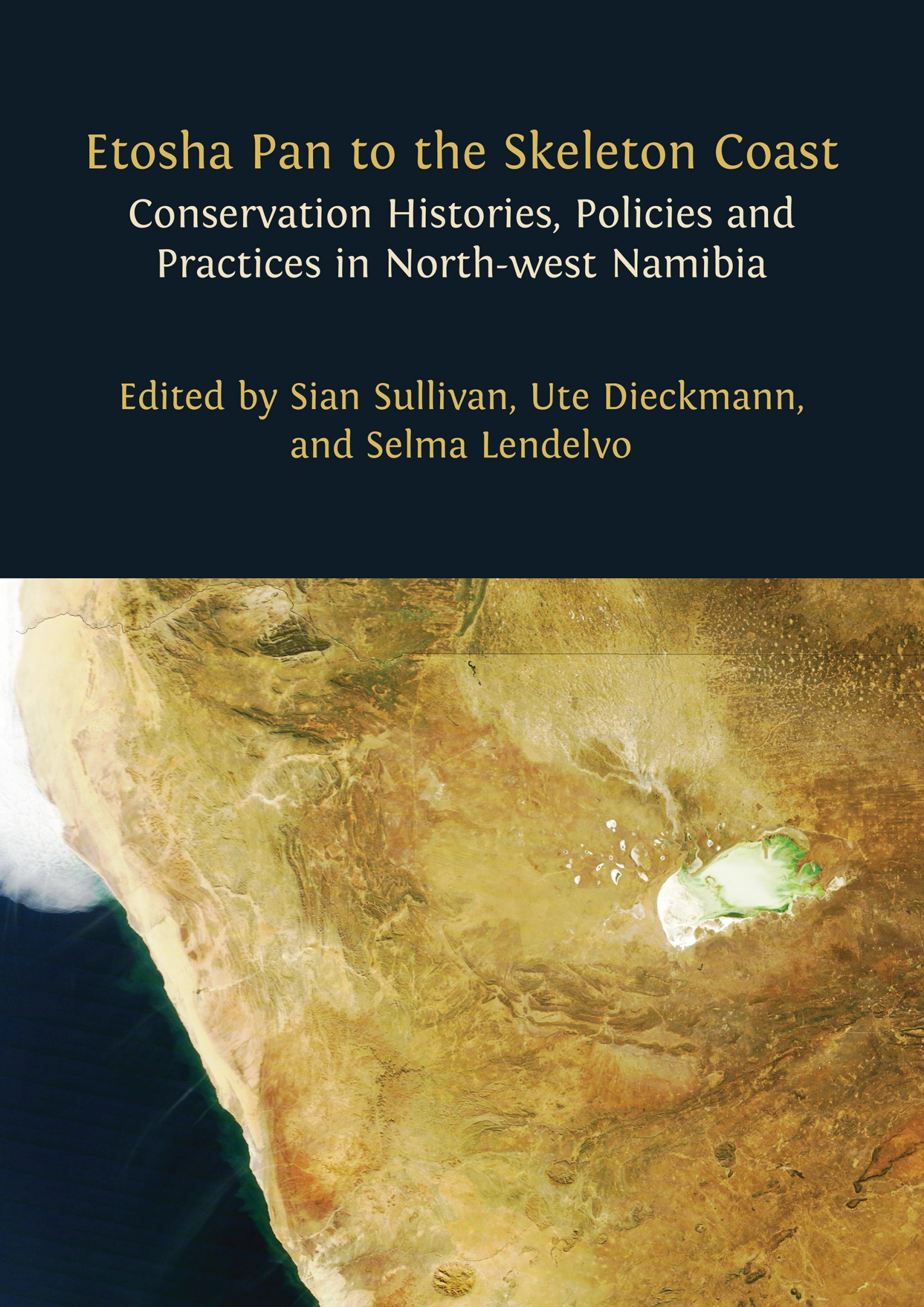9. Giraffes and their impact on key tree
species in the Etendeka Tourism Concession, north-west Namibia
©2024 K. Maoveka, D. Liebenberg & S. Sullivan, CC BY-NC 4.0 https://doi.org/10.11647/OBP.0402.09
Abstract
We report on a study that researched the impacts of browsing giraffe (Giraffa camelopardalis angolensis) on trees important for pollinators—namely, Maerua schinzii (ringwood tree) and Boscia albitrunca (shepherd’s tree)—within the Etendeka Tourism Concession area to the west of Etosha National Park. Giraffe are selective browsers, and the tallest land animal. Historically, giraffe populations have been amplified here through translocations designed to enhance the tourism product of the concession, which is situated in mopane (Colophospermum mopane) savanna, semi-desert and savanna transition vegetation zones. Due to browsing by giraffe, M. schinzii and B. albitrunca trees develop a distinctive shape with only a small, round, high-up canopy of leaves above a very high browse line, with some trees dying as a result. The study also explored five different techniques to protect these trees from further browse damage by giraffes.
9.1 Introduction1
Giraffe—Giraffa camelopardalis—is a large hoofed megaherbivore mammal with a wide, although in many places decreasing, distribution in Africa (see Figure 9.1). The subspecies Giraffa camelopardalis angolensis is found throughout Namibia, its distribution amplified in recent decades through translocations. Indeed, translocations to enhance the “tourism product” are one reason for their presence in areas of north-west Namibia, which might otherwise be too arid for the permanent presence of this herbivore. In some contexts in this area their presence has become a cause for ecological concern. This is the case for giraffe in the Etendeka Tourism Concession to the west of the Etosha National Park (ENP) (see Figure 9.2), an area located in a vegetation zone that is transitional between mopane savanna—dominated by the tree Colophospermum mopane—and semi-desert2 (see Section 9.2).
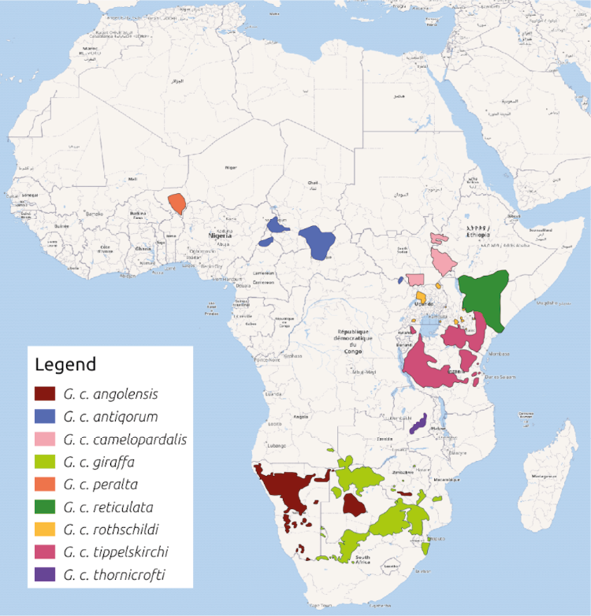
Fig. 9.1 Map showing the distribution of Giraffa camelopardalis and subspecies in Africa, as of 2018. Source: © BhagyaMani, drawing on Muller et al. (2018) and Winter et al. (2018), https://en.wikipedia.org/wiki/Giraffe#/media/File:Giraffa_camelopardis_distribution_2018.png, CC BY–SA 4.0. Note that translocations of G. c. angolensis from Namibia to southern Angola have also taken place since this map was drawn.
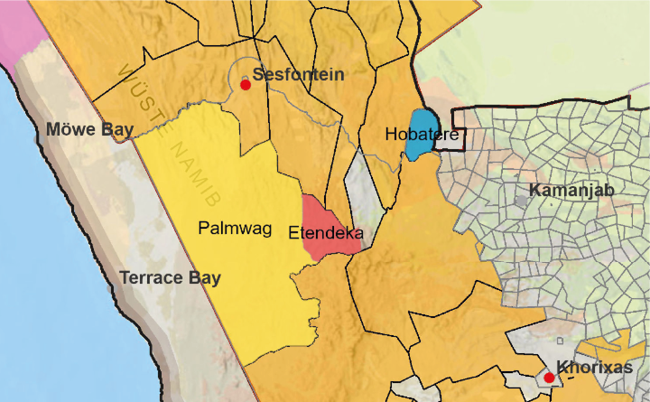
Fig. 9.2 Map showing the Etendeka Tourism Concession, positioned in between the Palmwag and Hobatere Tourism Concessions, with Etosha National Park in the east and the Skeleton Coast National Park in the west. The surrounding orange areas are communal area conservancies. The grey bounded areas in the south-east of the map are freehold farms. © Ute Dieckmann and Atlas of Namibia Team 2022, CC BY-NC-ND 4.0.
Giraffe are selective feeders and factors such as seasonal shifts in food quality and availability affect their browsing. At Etendeka, as well as in ENP, it is often observed that Maerua schinzii (ringwood) and Boscia albitrunca (shepherd’s tree), both members of the Capparaceae family, have a distinctive and reduced crown-shape caused by intense browsing by giraffe (Figure 9.3). In this dryland environment, the flowers of these tree species are especially important for pollinators, making them critical for the ecology of the area: reduction of their health and presence thus potentially has wider ecological consequences. For this reason, these tree species were selected for a study of the impacts of browsing giraffe at Etendeka.
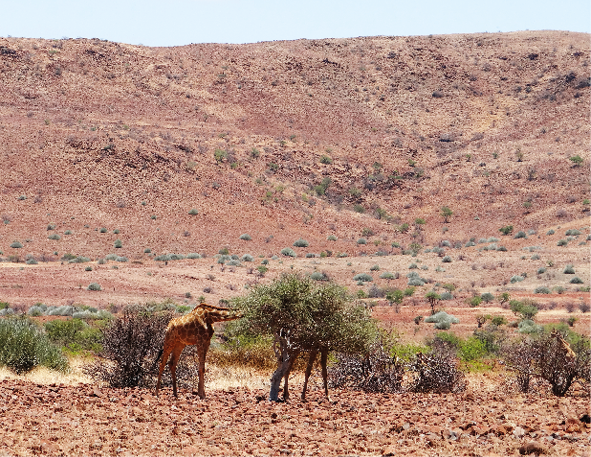
Fig. 9.3 Giraffe (Giraffa camelopardalis angolensis) browsing in the Etendeka Tourism Concession. Photo: © Sian Sullivan, 8.3.2024, CC BY-NC-ND 4.0.
Etendeka’s current giraffe population is linked to translocations of these mammals into the area in the 1980s and 1990s, starting with an initial translocation of giraffe to the farm Werêldsend, south of the !Uniab River, in 1983. The aim was to contribute to the touristic attractiveness of the area by enhancing its complement of large mammals. The research involved finding out about giraffe browsing behaviour in Etendeka, surveying, measuring and mapping especially M. schinzii and B. albitrunca in the concession, and assessing the level of browse damage (Sections 9.3 and 9.4). In addition, practical ways to protect these trees from further browse damage by giraffe were explored and are documented here (Section 9.5).
9.2 Study area
Etendeka is well known for its layered hills and flat-topped mountains, broken by ephemeral rivers and permanent water springs. Indeed, Etendeka is an otjiHerero word derived from ‘Omatendeka’ meaning layered hills or mountains. Damara/ǂNūkhoen refer to the area as ǂNauraheb,3 meaning broken up or breaking up. Both local/Indigenous names reflect the geology and topography of the area which is distinguished by layered flat-top table mountains covered with broken up basalt lava rocks, as can be seen in Figure 9.4. This geologically interesting area4 lies between the Grootberg in the east and the Goboboseb mountains in the west. Before the Atlantic Ocean came between the African and South American continents as the Gondwana super-continent broke up more than a 100 million years ago, volcanic activity melted the earth’s crust causing lava flows from more than 100 km under the earth’s surface to rise to the surface, flowing down huge fissures and covering the Etendeka area in north-west Namibia.5 This magma formed the 78,000 km2 Etendeka Plateau6 and Awahab Outliers, covered with a lava sheet approximately two kilometres thick, and was followed by the split between Africa and South America.7 The area is very dry, its annual average rainfall ranging from 100-110 mm. It mostly rains when the wind blows from the east, gathering heat as it moves over the inland plateau. When wind blows from the coast in the west it tends to be cooler.
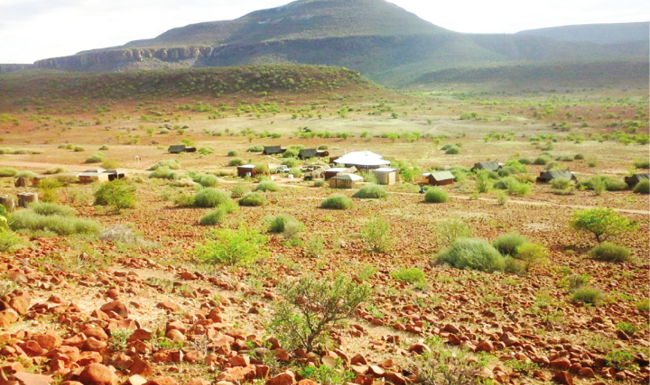
Fig. 9.4 Etendeka Mountain Camp in the Etendeka Tourism Concession, showing the layered table-top mountains and broken basalt lavas characteristic of this area. Photo: © Kahingirisina Maoveka, 2016, CC BY-NC-ND 4.0.
This project was conducted under the guidance of Etendeka Mountain Camp8 management, the sole lodge in the Etendeka Tourism Concession. The Etendeka Concession comprises a triangular area of 50,000 ha of the Damaraland Communal Land Area (as defined in the Communal Land Reform Act of 2002), near the Grootberg on the edge of the Northern Namib Desert in Kunene Region (Figure 9.2). For a short period starting in 1958, the area was part of an expanded area designated as Game Reserve No. 2. From 1962 to 1970, the south-west boundary of Etosha Game Park (renamed Etosha National Park in 1967), ran slightly to the north of the present position of Etendeka Mountain Camp (see Chapter 2, especially Figures 2.2 and 2.3). Figure 9.5 shows boundary markers along the cutline forming the southern border of the 1962–1970 Etosha Game Park / Etosha National Park boundary, to the west of the current ENP.
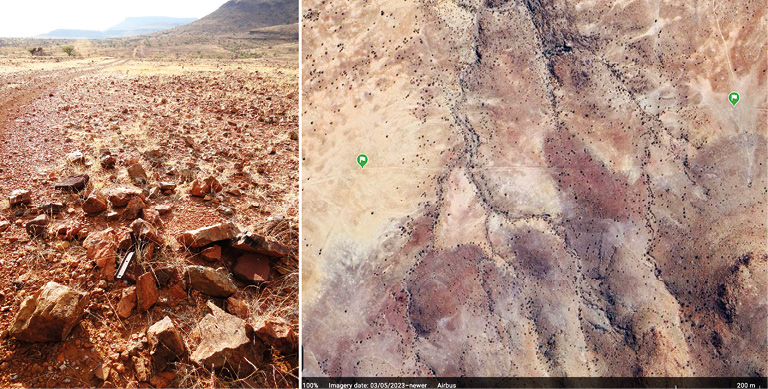
Fig. 9.5 Boundary markers along the cutline track of the southern border of the 1962–1970 Etosha Game Park/Etosha National Park, north of Etendeka Mountain Camp in the Etendeka Tourism Concession. The marker in the foreground of the image on the left is the marker on the left of the birds-eye view image on the right. The cutline running diagonally south-west in the bottom left corner of the right-hand image marks an access road to the plateau, originally established by the farmer (Krenz) who held the commercial farm Otjihavera in the 1950s, now part of the Etendeka Concession. Photo on left: © Sian Sullivan, 17.4.2023, drawing on information from Duncan Gilchrist, pers. comm., during site visit, corroborated by pers. comm. information to Dennis Liebenberg from Rudi Loutit (formerly of the Ministry of Environment and Tourism) and the late Garth Owen-Smith (formerly of Integrated Rural Development and Nature Conservation); image on right compiled on Google Earth using data from AirbusMaxar TechnologiesImagery from 3.5.2023 onwards. Both images CC BY-NC-ND 4.0.
In the mid-1980s under the former Damaraland Regional Authority (DRA), Etendeka became a tourism concession, alongside the Palmwag and Hobatere concessions (see Chapter 13). No hunting is currently permitted in these areas, although the area was part of a large hunting concession from the 1970s into the 1980s. Co-author Liebenberg, formerly a shareholder in Namib Wilderness Safaris,9 has been Etendeka’s Concession operator for more than 25 years, during a period of significant change in conservation in Namibia, marked especially by the establishment of community-run conservancies (see Chapters 3 and 5). As shown in Figure 9.2 the Etendeka Concession now shares its western boundary with the Palmwag Tourism Concession, its north-eastern boundary with Anabeb and Omatendeka conservancies, and its southern boundary with Torra and ǂKhoadi-ǁHôas conservancies. Since March 2012, the Etendeka Mountain Camp enterprise has been run as a joint venture with Anabeb and Omatendeka conservancies, such that the fixed assets of the enterprise belong to these conservancies. The tourism concession is now a shared partnership jointly owned by the investor and the conservancies under Big Sky10 management.
Alongside Wilderness Safaris’ Desert Rhino Camp in the Palmwag Concession, Etendeka Mountain Camp is one of the first lodges in Namibia to earn a five-flower “eco-award” rating for being environmentally friendly.11 The camp uses solar power, is careful with the use of water and wood, and was one of the first tourist enterprises in Namibia to pay a share of income to conservancies bordering the concession. The camp concession-holder and manager (co-author Dennis Liebenberg) collaborates closely with the surrounding conservancies, the Ministry of Environment, Forestry and Tourism (MEFT) and Save the Rhino Trust (SRT)12 in managing the area for both tourism and conservation. Ongoing monitoring programmes are the annual game count in June, carried out by driving along a specified route and counting animals within a distance from the road,13 and lion monitoring based on photographs and tracking data from fitted satellite collars and telemetry equipment (see Chapters 17, 18 and 19). Black rhino (Diceros bicornis bicornis) also move through the area which is monitored and patrolled by SRT Rangers.
Alongside giraffe, the area hosts a variety of desert-adapted large and small mammals. Species include Equus zebra hartmannae (mountain zebra), Tragelaphus strepsiceros (greater kudu), Oryx gazella (oryx), Raphicerus campestris (steenbok), Oreotragus oreotragus (klipspringer), Crocuta crocuta (spotted hyena), Proteles cristata (aardwolf), Panthera leo (lion), P. pardus (leopard), Xerus princeps (Damara ground squirrel), Lupulella mesomelas (black-backed jackal), Acinonyx jubatus (cheetah), as well as a new species of elephant shrew, Macroscelides micus (round-eared Etendeka sengi).14 The concession is also home to several endemic birds, including Ruppell’s korhaan (Heterotetrax rueppelii), Monteiro’s hornbill (Tockus monteiri), the rockrunner (Achaetops pycnopygius), and the Benguela long-billed lark (Certhilauda benguelensis).15 Resident reptiles include lizards like Namibian rock agama (Agama planiceps), tree agama (Acanthocerus atricollis), common striped skink (Trachylepsis striata), Namaqua sand lizard (Pedioplanis namaquensis), rock monitor (Varanus albigularis), web-footed gecko (Pachydactylus rangei), and several snakes including the black mamba (Dendroaspis polylepis), horned adder (Bitis caudalis) and western barred spitting cobra (Naja nigrocollis nigricincta).
In terms of vegetation and, as noted in Section 9.1, the Etendeka Concession is in a transition area between mopane savanna and semi-desert with few large trees.16 As well as M. schinzii and B. albitrunca, characteristic woody plants adapted for aridity include Sterculia africana (African star chestnut) and Sterculia quinqueloba (large-leaved sterculia), Boscia foetida (smelling shepherd’s tree) and Pachypodium lealii (bottle tree), and the endemics Combretum wattii (Kaoko combretum) and Acacia robynsiana (whip-stick acacia). Succulent euphorbias include Euphorbia damarana (Damara euphorbia), Euphorbia mauritanica (yellow milk bush), and Euphorbia virosa (candelabra euphorbia). In Figure 9.4 above the dominant plants are mopane trees and the rounded Damara euphorbia, a favourite food of black rhinos and greater kudu.
9.3 Aims and methods
The field research for this project was carried out as “Work Integrated Learning” as part of a Bachelor of Natural Resource Management (Nature Conservation) degree at the Namibia University of Science and Technology (NUST). The main aim was to document the impacts of browsing giraffe in the Etendeka Concession Area on especially M. schinzii and B. albitrunca over five years between 2016 and 2021. An additional objective was to explore practical ways for preventing further damage to these important tree species (Section 9.5).
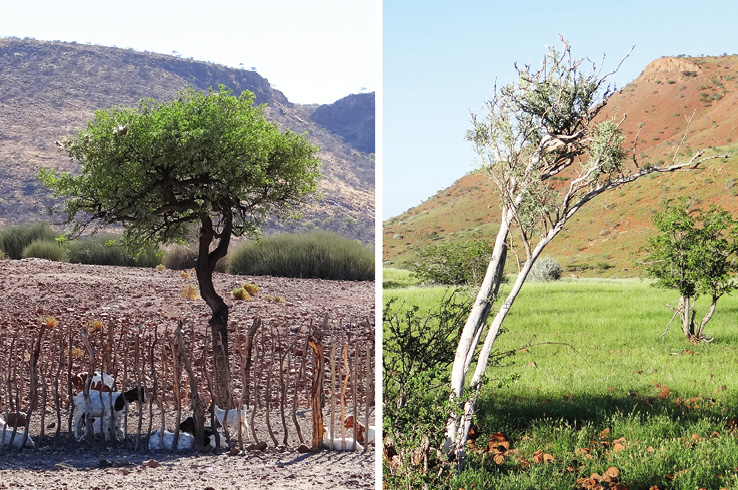
Fig. 9.6 Maerua schinzii (left) is a valued forage tree that often forms the centrepiece of goat kraals for farmers in conservancies beyond the concession boundaries—as shown here at !Nao-dâis, on the northern boundary of the Etendeka Concession. Boscia albitrunca (right) photographed within the Etendeka Concession. Photos: © Sian Sullivan 13.11.2014 and 27.3.2022, CC BY-NC-ND 4.0.
The growth form of M. schinzii and B. albitrunca is alike (see Figure 9.6). Maerua schinzii occurs throughout the north-western, central and central southern parts of the country but is not found in the arid Namib, the Kalahari vegetation zones or in north-eastern Namibia. It often has a single trunk that may be crooked or twisted because of growing under or against other trees such as mopane that protect its saplings from being eaten by herbivores when they are small.17 The species has bead-like fruit, simple, green leaves with long petioles as well as wrinkle-like rings on the bark, often at the base of the branches, hence its common name as ringwood tree. The trunk can sometimes look white from one side and dark on the opposite side (pers. obs. by Maoveka). Boscia albitrunca (shepherd’s tree) is common in the drier parts of southern Africa. Mannheimer and Curtis18 observe this species to be widespread throughout Namibia, except in areas of the Namib Desert and in the south where tree growth is limited. It also normally has a single trunk with white smooth bark or sometimes a whitish grey stem. It has single, green-grey leathery leaves and rounded yellowish fruits with single seed. In 2021 an additional tree species—Parkinsonia africana—was also surveyed due to observations that this species too is being affected by browsing giraffe.
A field survey of M. schinzii and B. albitrunca populations in 2016 and 2021, including P. africana in 2021, was thus conducted within the Etendeka Concession area. The presence of these species along key routes in the concession was mapped for individuals within 50 m from both sides of the main route from Etendeka Mountain Camp to the main road to Sesfontein, and from the camp to Palmwag, with GPS coordinates recorded for each individual included in this sample, as shown in Figure 9.7.
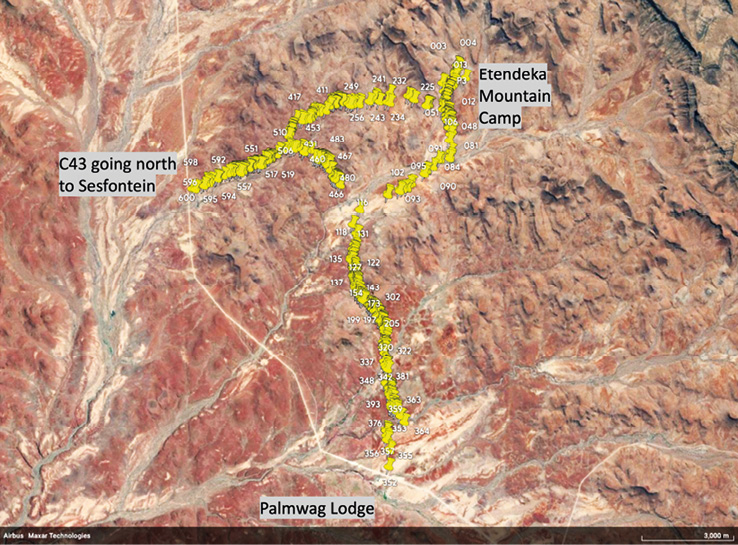
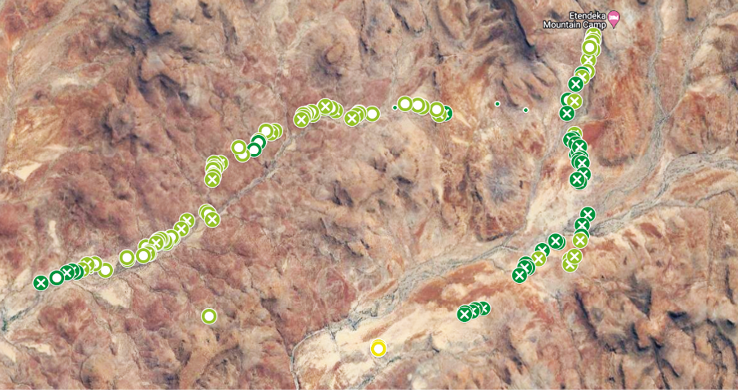
Fig. 9.7 Mapped locations of measured trees included in this study. Top image: full tree survey in 2021. Bottom image: detail from 2021 showing the different species included in the survey – key: dark green = Maerua schinzii; pale green = Boscia albitrunca; yellow = Parkinsonia africana; circles = live adult trees; crosses = dead trees; dots = juveniles individuals. Source: Kahingirisina Maoveka’s research database, bottom image mapped by Sian Sullivan, CC BY-NC-ND 4.0.
The following information was recorded so as to provide an indication of the population structure and recruitment19 of these selected tree species in the Etendeka Tourism Concession:
- in 2016, dead trees (e.g. those showing zero green growth and/or no longer standing) and live trees were recorded to determine the ratio of alive, dead and juvenile B. albitrunca and M. schinzii in the concession area. This survey was repeated in 2021, when P. africana was also included;
- the seedlings or juvenile trees of 30 cm and above were counted so as to indicate sapling occurrence and thus recruitment to species populations, observing that many juveniles use the protection of mopane trees or E. damarana to assist their growth. As above, the survey in 2016 focused on B. albitrunca and M. schinzii, with P. africana included in 2021;
- browse damage was also recorded for tree individuals included in the experiments to protect live mature individuals of M. schinzii and B. albitrunca (see Section 9.5), following the five score scale in Table 9.1.
Table 9.1. Scoring system used for assessing extent of browsing by Giraffa camelopardalis angolensis on Maerua schinzii and Boscia albitrunca at Etendeka Tourism Concession in 2016 and 2021, and Parkinsonia africana in 2021.
9.4 Results
In this section we report on the findings of this assessment of the population structure of tree species selected for study in this survey. In 2016, 604 individuals of dead, alive and juvenile M. schinzii and B. albitrunca were observed and counted within the Etendeka Concession Area on the route mapped in Figure 9.7. Many more B. albitrunca were counted than M. schinzii, with the numbers of apparently dead M. schinzii comprising a higher proportion of the population of this species than for B. albitrunca: as graphed in Figure 9.8. In 2016, as Figure 9.8 shows, B. albitrunca seemed to be thriving relative to M. schinzii, in terms of displaying a higher proportion of alive trees compared with those recorded as dead. This pattern, however, was reversed for recorded juveniles of these two species, for which M. schinzii was recorded to have far higher numbers than B. albitrunca, indicating more robust recruitment of the former species compared with the latter.
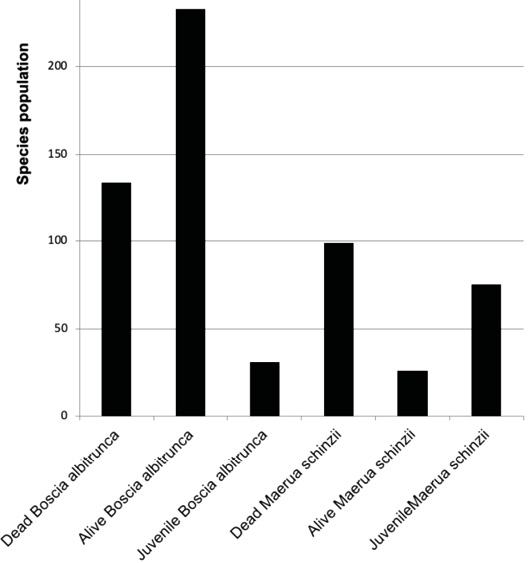
Fig. 9.8 Graph showing the results of the survey of dead, alive and juvenile Boscia albitrunca and Maerua schinzii in the Etendeka Tourism Concession in 2016. Source: Maoveka’s research database, CC BY-NC-ND 4.0.
In the repeat survey in 2021, 479 individuals of B. albitrunca, M. schinzii and P. africana were counted within the Etendeka Concession Area and their status as dead, alive and juvenile recorded. As shown in Figure 9.9, the numbers of dead relative to thriving M. schinzii remained very high in comparison to B. albitrunca, and the latter species seemed to be thriving relatively well in comparison with the former. It was observed that giraffe seem to prefer M. schinzii to B. albitrunca and it is assumed that this preference is contributing to negative impacts on the population structure of M. schinzii. On the other hand, juveniles of M. schinzii were observed to be doing well compared to those of B. albitrunca because most of them grow close to older mopane trees which protects them from being browsed. The crowns of individuals of mature B. albitrunca and M. schinzii were observed to have quite unusual shapes as a result of browsing by giraffe. The population of P. africana is shown to be relatively small at Etendeka, but with more alive individuals than dead: recruitment thus appears healthy with mature individuals observed to be flowering, indicating that the population of this species is surviving.
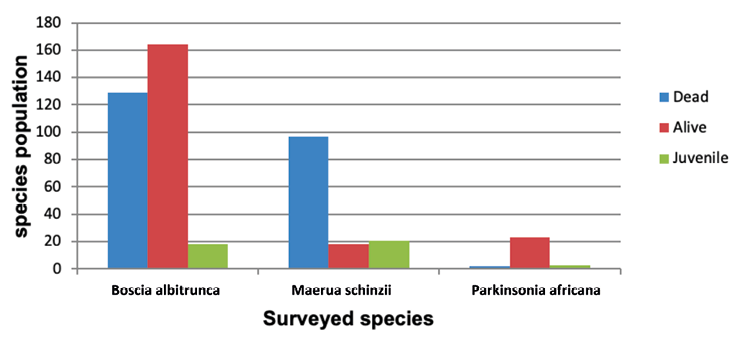
Fig 9.9 Graph showing the results of the 2021 survey of Boscia albitrunca, Maerua schinzii and Parkinsonia africana in the Etendeka Tourism Concession showing proportions of dead, alive and juvenile individuals counted for each species. Source: Maoveka’s research database, CC BY-NC-ND 4.0.
An additional cause for some concern is that termites have been observed to be damaging some M. schinzii with leaves above the browse line of the giraffes. Termites have started working on live Maerua which weakens their limbs making these individuals susceptible to breaking branches, with branches or even the whole tree falling in strong winds. Termites build their colonies around the tree stem up to the branches on which they feed. They work very fast: in some instances dead trees recorded in 2016 had been completely consumed when revisited in 2021, leaving patches of bare ground and contributing to the discrepancy in the number of surveyed trees between 2016 and 2021.
9.5 Protecting live Maeura schinzii and Boscia albitrunca trees
This section assesses experiments made to protect live mature M. schinzii and B. albitrunca trees within the Etendeka Tourism Concession. Table 9.2 lists seven trees selected for protection from browsing giraffe, and the different methods used for their protection—focusing especially on the more threatened M. schinzii. Five different methods were used to protect the trees from further damage by the giraffes and seven individual trees in total were protected. All of the methods were quite labour intensive. To assess the effectiveness of each method, browsing scores and other indicators of tree health were recorded for each individual in the first week of protection in 2016, and again during the repeat survey in 2021.
Table 9.2. Techniques used in 2016 to protect selected mature Maeura schinzii and Boscia albitrunca trees from browsing by giraffe, with browsing scores – as per Table 9.1 – and other health indications recorded for 2016 and 2021.
|
Protected trees |
Method used |
Browse scores |
Browse |
|
Boscia albitrunca |
Standing rocks |
1 |
1 |
|
Maerua schinzii |
Rock wall |
4 |
1 |
|
Corrugated iron |
4 |
1 |
|
|
Fenced |
1 |
1 |
|
|
Fenced |
5 |
1 |
|
|
Branches |
5 |
Dead |
|
|
Branches |
5 |
Dead |
The first tree selected was a B. albitrunca individual, protected with rocks from the Etendeka landscape (Figure 9.10). It took about a week to complete this form of protection because a lot of rocks were needed and these had to be brought to the location from the surrounding landscape. Standing rocks were packed together around the tree for about 60 cm from the base of the stem to 2 m away from the tree canopy. The rocks were placed in such a way that sharp or pointed edges were placed upright to make the area around this tree uneven for giraffe to step on. This method is suitable for the concession area because it blends into the scenery. It has also been used in different areas to prevent elephant from approaching water tanks. Nevertheless, the browse score for this tree in 2021 was the same as in 2016.
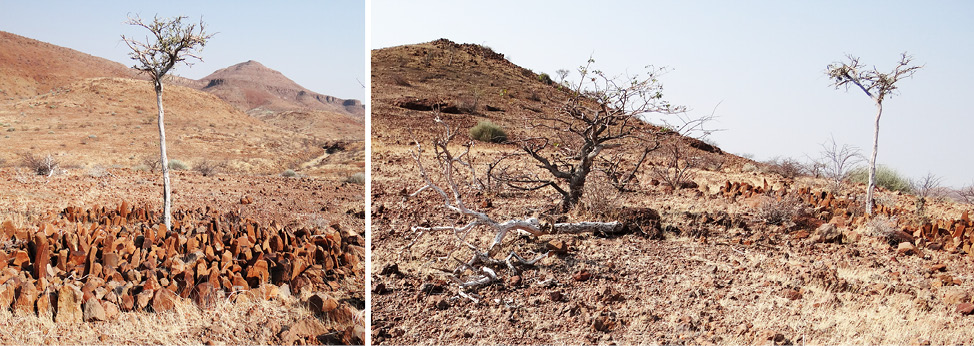
Fig. 9.10 Image on the left shows a mature Boscia albitrunca protected with standing rocks in 2016. Image on the right shows this same tree to the right of the image with an unprotected and now dead B. albitrunca visible on the left of the image. Photos: © Sian Sullivan, 14.9.2023, CC BY-NC-ND 4.0.
Different techniques were experimented with for protecting M. schinzii from browsing giraffe:
- a rock wall about a metre high and two metres away from the tree canopy was built around M. schinzii. This height was chosen because it was the highest recorded for giraffe jumping when chased;
- a half a metre rock wall was built, and sheets of corrugated iron were placed inside to act as reflectors of the sun to scare giraffe away from the tree. The corrugated iron was placed in such a way that if giraffe try to step onto the wall the iron produces a sound that also startles them away from the tree. In this case, the protected tree showed relatively good leaf growth over the five years since protection (see Figure 9.11);
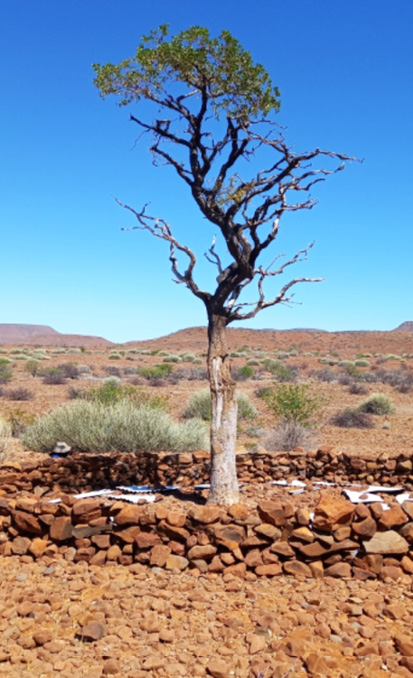
Fig. 9.11 Maerua schinzii protected by stone wall with corrugated iron reflectors inside. Note the very high browse line, characteristic of browsing by giraffe. Photo: © Kahingirisina Maoveka, 2021, CC BY-NC-ND 4.0.
- for two mature M. schinzii a 2.2 m wire mesh fence was erected around each tree, about two metres away, attached to poles dug half a metre into the ground. For one of these sites, two juvenile M. schinzii have grown from the roots of the original mature tree, which had died in-between. This technique of fencing prevented the giraffes from feeding from both trees, with one becoming a small bush by 2021. At the second of these sites the protected adult individual had few leaves remaining in 2016, but in 2021 displayed new shoots from the lower part of its trunk, with a new juvenile around 1.5 m high also growing inside the fence. It thus appears that fencing can be used to protect these trees from browsing giraffe, although the fences do not blend so well into the scenery and thus the method is less attractive for tourism purposes;
- finally, thorny branches from Terminalia prunioides—a species that is expanding in some areas of the concession—were also placed around two heavily browsed M. schinzii trees around two metres away, alongside branches from E. damarana. The M. schinzii protected in this way did not survive, which may be because they had already been browsed so heavily by 2016 when they were selected for protection. Advantages of this method of protection is that the branches placed around the trees look natural and provide habitat for small mammals and other creatures.
Since these experiments were initiated many more trees have been protected in the Etendeka Concession, using especially the second method outlined here and shown in Figure 9.11.
9.6 Conclusion
This study was carried out so as to add to knowledge regarding the impact of browsing by giraffe on important tree species within the Etendeka Tourism Concession. Here, giraffe translocated into the concession and then breeding there have been observed to have a significant impact on especially M. schinzii, but also B. albitrunca, tree species that are particularly important for pollinators. As well as providing an indication of the effects of browsing on the population structure and recruitment of these two species, an aim was to experiment with methods of protecting these trees from browsing giraffes. It seems that the method of building a rock wall with corrugated iron placed inside is the most appropriate for this area: it is effective in preventing giraffe browsing the protected trees, and thereby allows new leaf growth to take place. Additionally, this method blends relatively well into the Etendeka scenery (see Figure 9.11) and thus protects the tourism product of the Etendeka Mountain Camp enterprise.
Overall, it can be concluded that a more explicit “multispecies” approach is needed when considering wildlife management approaches such as translocations of megaherbivores into a dryland area such as Etendeka/ǂNauraheb. It is clearly important to assess impacts on the ecology of an area as a whole (also see Chapter 10). Otherwise, translocations that may be deemed to improve the “tourism product” of an area may have far-reaching detrimental ecological effects in the long run.
Bibliography
Berry, C. and Loutit, B. 1978. Trees and Shrubs of the Etosha National Park. Windhoek, Namibia: Gamsberg.
Giess, W. 1998[1971]. A preliminary vegetation map of Namibia. Revised Edition. Dintera 4: 5–114.
Grünert, N. 2000. Namibia—Fascination of Geology. Windhoek: Klaus Hess Publishers.
Jerram, D.A., Mountney, N., Holzförster, F. and Stollhofen, H. 1999. Internal stratigraphic relationships in the Etendeka Group in the Huab Basin, NW Namibia: understanding the onset of flood volcanism. Journal of Geodynamics 28(4): 393-418, https://doi.org/10.1016/S0264-3707(99)00018-6
Mannheimer, C.A. and Curtis, B.A. (eds.) 2005. Le Roux and Muller’s Field Guide to the Trees and Shrubs of Namibia. Windhoek: Macmillan Education Namibia.
Muller, Z. Bercovitch, F., Brand, R., et al. 2018. [amended version of 2016 assessment]. Giraffa camelopardalis. IUCN Red List of Threatened Species 2018: e.T9194A136266699, https://doi.org/10.2305/IUCN.UK.2016-3.RLTS.T9194A136266699.en
Rathbun, G.B., Osborne, T.O. and Coals, P.G.R. 2015. Distribution of the Etendeka round-eared sengi (Macroscelides micus), a Namibian endemic mammal. Journal of Namibian Scientific Society 63: 153–57.
Simmons, R.E., Brown, C.J. and Kemper, J. 2015. Birds to Watch in Namibia Red, Rare and Endemic species. Windhoek: Ministry of Environment and Tourism (MET) and Namibia Nature Foundation (NNF).
Sullivan, S. 1999. The impacts of people and livestock on topographically diverse open wood-and shrub-lands in arid north-west Namibia. Global Ecology and Biogeography 8: 257–77, https://doi.org/10.1046/j.1365-2699.1999.00131.x
Sullivan, S., Konstant, T.L. and Cunningham, A.B. 1995. The impact of the utilization of palm products on the population structure of the Vegetable Ivory Palm (Hyphaene petersiana, Arecaceae) in north-central Namibia. Economic Botany 49(4): 357–70, https://www.jstor.org/stable/4255772
Winter, S., Fennessy, J. and Janke, A. 2018. Limited introgression supports division of giraffe into four species. Ecology and Evolution 8(20): 10156–65, https://doi.org/10.1002/ece3.4490
1 Acknowledgments: the first author would like to express gratitude towards the members of Etendeka Mountain Camp for their kind cooperation and encouragement, especially Mr. Dennis Liebenberg, Boas Musaso and Bonnie |Awareb, as well as to her tutor Ms. Shirley Bethune, who took a keen interest in this project and assisted with its completion.
2 Giess (1998[1971])
3 Pers. comm. Welhemina Suro Ganuses, Sesfontein, 5.9.2023.
4 Jerram et al. (1999)
5 Grünert (2000)
6 Ibid.
7 Rathbun et al. (2015)
11 S. Bethune, pers. comm., 24.1.2016. See https://ecoawards-namibia.org/
13 The latest game count for north-west Namibia of which Etendeka is part can be found at https://www.nacso.org.na/sites/default/files/North%20West%20Game%20Count-Regional%202022%20final.pdf
14 Rathbun et al. (2015)
15 Simmons et al. (2015)
16 Giess (1998[1971])
17 Berry & Loutit (1974)
18 (2005)
19 Meaning the growth of young individuals that may potentially contribute to the future population of these tree species. For similar studies of population structure and recruitment for woody species in Namibia see, for example, Sullivan et al. (1995) and Sullivan (1999: 268–71).
